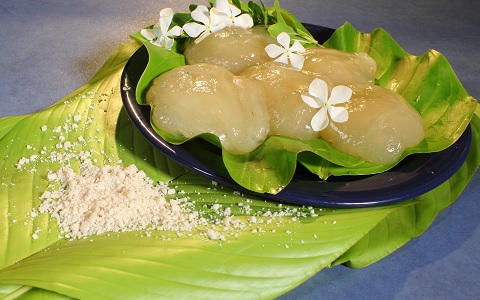By Marie Kauna – EMTV Online, Port Moresby
Nangu is a common dish that is prepared and known all over both the East and West Sepik Provinces. Locals from different parts of Sepik Province prepare Nangu as part of their daily meal. It is common and the preparation doesn’t take much time. Apart from other foods like yam, taro and kaukau, the locals believe that Nangu is still the best.
Yuo Island around the West Coast, the locals call their Nangu dish ‘Rebi’. Rebi is prepared using specially prepared white sago, which is stored in the water, before being used in the dish. The things needed to prepare Rebi include a dish, boiling hot water, a big wooden spoon called ‘Ivil’, two wooden chopsticks called ‘Sasek’, and the dry powdered sago which is white or sometimes pinkish.
The preparation time doesn’t take long and is believed to be less than three minutes. This depends on how hot the heat being produced from the fire is, to actually boil the pot of water. The quantity of sago to be used depends on the total number of people there are to feed.
The first step in Rebi preparation is boiling hot water. Water is boiled and set ready. The next step requires one to remove the dry sago from the storage. This dry sago is safely stored in a pot of water. It is believed that only through this way of storing; the sago is still fresh and can only be used for Rebi preparation, and not other dishes. In the past, the older generation used clay pots to store their sago and stored it away in water for Rebi.
While the water boils, the stored dry white sago is removed and poured into a bowl. In the past, the ancestors used traditional wooden bowls that were made from special wood. At this stage, the sago doesn’t go through further processing because it is strained nicely during the stages of extraction from the sago plant. Traditionally, the locals used coconut strainers to strain the waste material off from the fine sago product.
Once in the bowl, hot water is added. The hot water is added gently using the big wooden spoon Ivil. The process of adding the hot water continues. At the same time, a big wooden Ivil is used to stir the added hot water with the sago, so they both blend to mix well. This process requires a lot of hot water. More water is added to the sago and more stirring continues until all the dry sago is completely covered with hot water, and is mixed gently. Gentle stirring continues until the dish and its contents resemble a jelly-like mixture.
When the the sago looks like this, the Rebi is almost at its final stage, ready to be eaten. But before it can be eaten, the sago is beaten up. This is when hot water is no longer added and only the beating takes place. The beating up of sago concludes the whole process of preparing a Rebi. Then Rebi is ready and can be eaten.
Yuo locals have a special way of serving Rebi. It is served using two long sticks much like chopsticks called Sasek. Rebi is served by rolling out sago in small ball shapes onto the plate. In the past, special leaves were used to serve Rebi and they still use them today. They used Katleu, the breadfruit leaves, and the young coconut leaves. These leaves were not only used for serving and dishing out Rebi but were also used for storing away Rebi for later use. Today, the locals still use these leaves to wrap Rebi and store away.
The stored Rebi wrapped with these leaves can last for five days and will not go bad. Even after the fifth day, Rebi is still fresh and can be eaten. The special way of preserving the cooked Rebi has been practiced by their ancestors and the practice is still carried on till this day.
After the final beating, Rebi is served and eaten. According to a local from the area, Rebi is best eaten with creamed soup of any kind of cooked protein. Past generations had Rebi with creamed fish because fish is the main source of protein on the island. Today, the locals eat Rebi with either creamed fish or creamed chicken, so long as there is soup from a cooked source of protein. Rebi is said to go well with soup of any kind.
The cooking doesn’t take long, less than two minutes. It is very nutritious, delicious and can satisfy one’s hunger just within two minutes. The fastest prepared meal that anyone can prepare to eat and is very healthy.


